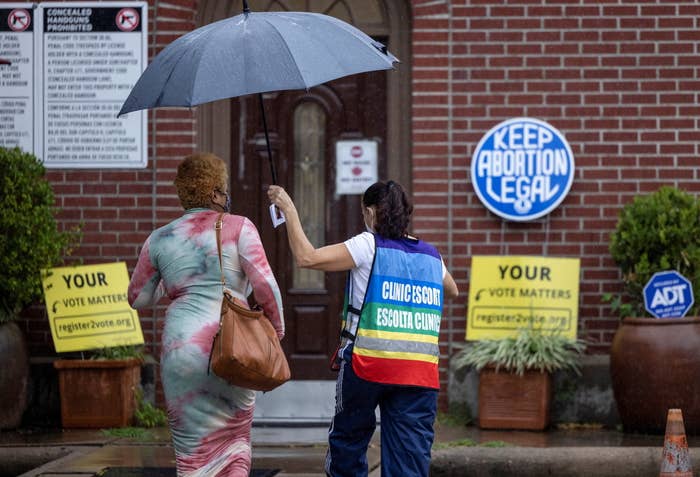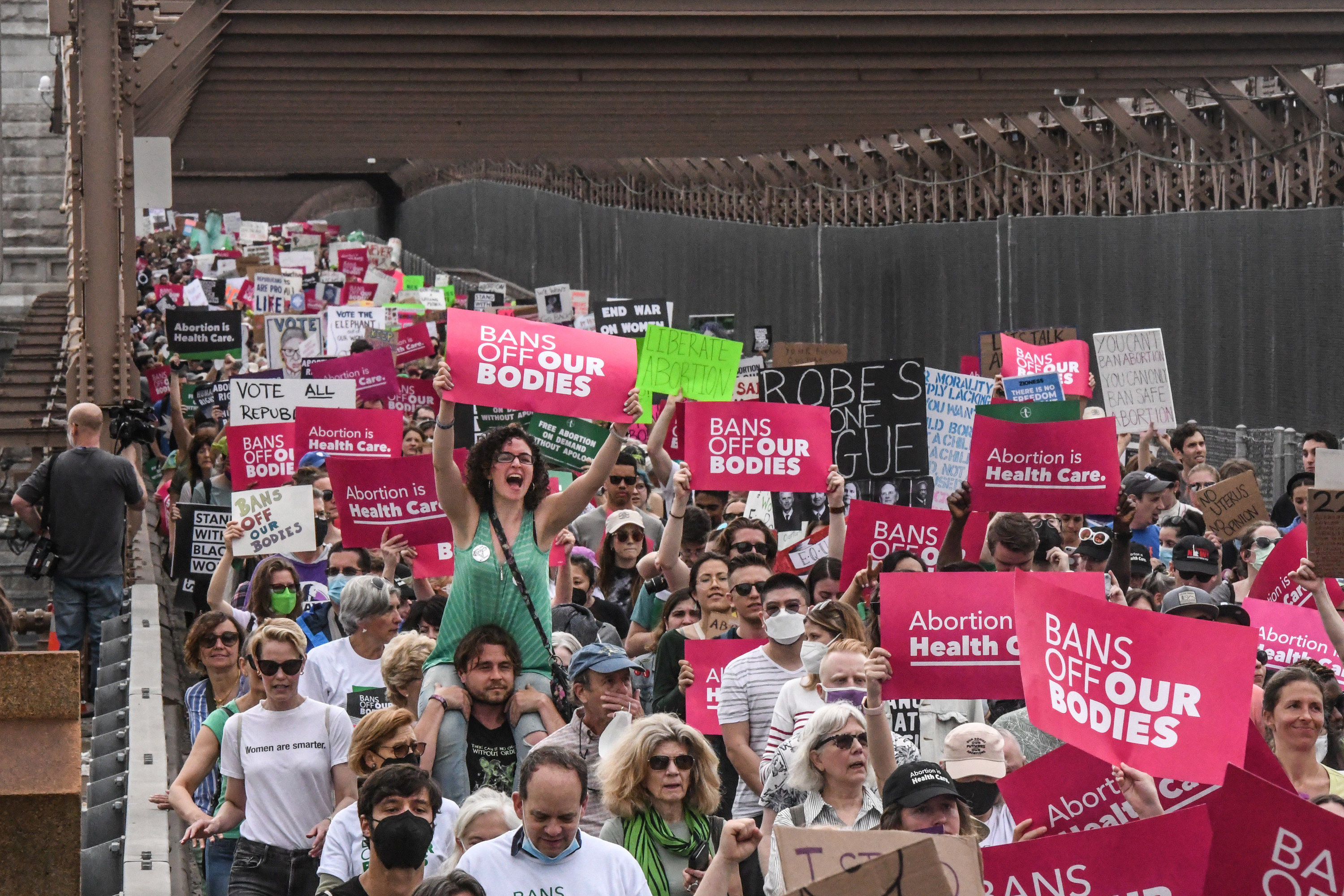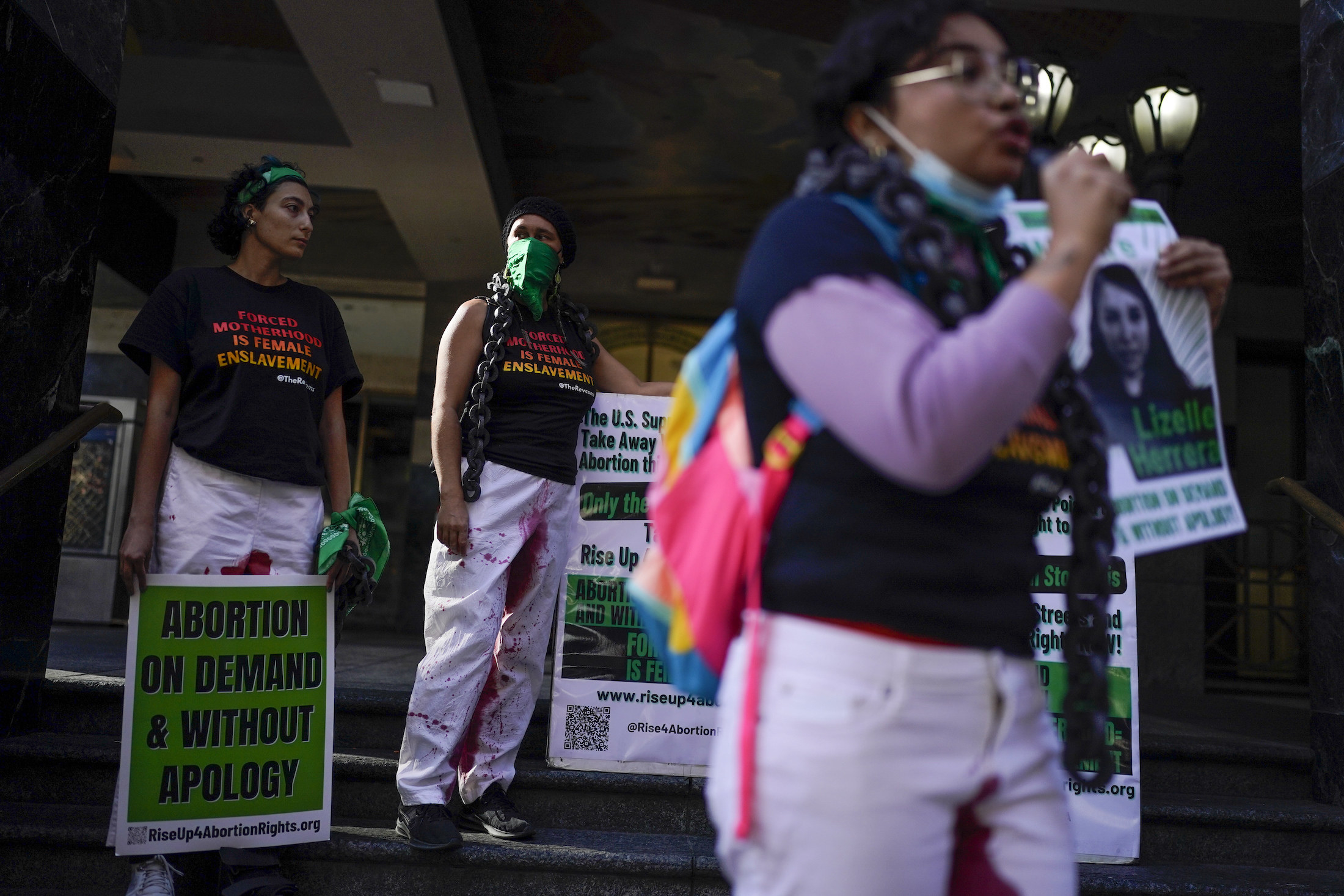
Nationwide access to abortion is crumbling now that the Supreme Court has overruled Roe v. Wade, the landmark 1973 decision that guaranteed it as a constitutional right.
Twenty-six states are expected to swiftly outlaw or severely restrict the medical procedure, forcing their residents to go elsewhere for care. People who can afford to travel may overwhelm clinics in areas where abortion is protected, leading to delays for everyone, while those with low incomes, who are disproportionately people of color, may be forced to carry unwanted pregnancies because they lack the means to leave.
It’s a reality that is difficult to grapple with. But there are things you can do to keep up the fight for abortion rights, support people who need care, and help the healthcare workers who provide it.
“The biggest thing that folks can do is to lean in to supporting their communities, to get involved politically, and to not lose hope,” said Kelley Robinson, executive director of the Planned Parenthood Action Fund. “This is going to be a challenging period, but we are going to come together and really transform what rights and access look like on the other side.”
Fund abortions in your community
Donating to your local abortion funds, which are grassroots organizations that directly provide money and logistical support to people seeking abortions, is one way to help those who need financial assistance to pay for travel expenses, childcare, and other costs.
“Start a monthly donation,” said Renee Bracey Sherman, the founder and executive director of the reproductive justice nonprofit group We Testify. “Look up your city plus ‘abortion fund’ and fund abortions locally.”
Funds in states where access is eliminated or severely restricted will need more financial support as people need to travel farther to access care. But even if you live in a state where abortion is protected, you should still donate to funds and clinics near you, Bracey Sherman said. “Just because New York and California have good laws doesn't mean people don’t have a hard time accessing abortion.”
She also recommended people donate to Keep Our Clinics, a campaign led by the Abortion Care Network that aims to support independent clinics. Money is used for payroll, rent, medical supplies and equipment, security improvements, legal costs, and building repairs, according to its website.
Volunteer to provide practical support

People can also volunteer to drive people to abortion appointments, coordinate lodging, and provide other kinds of practical support to patients. You can also serve as a clinic escort to help physically protect and shield patients facing down anti-abortion protesters.
Tamara Marzouk, the director of abortion access at Advocates for Youth, recommended people check out Apiary for Practical Support’s website to connect with a nearby organization and learn about other ways to help people access abortion services.
“Do your research about what exists in your community already and … absolutely start something if there is a need and if no one is doing the work already,” Marzouk said.
Take to the streets, call lawmakers, and vote
As Democrats have emphasized in recent weeks, the fall of Roe has made voting in this year’s midterm elections all the more important. But for people who need abortion care now and over the summer, that’s too late — and advocates say voting is not enough.
“People need to pour into the streets, and they need to bring this country to a halt,” said Sunsara Taylor, one of the initiators of Rise Up 4 Abortion Rights, which has been organizing marches and rallies across the US. “There should be no business as usual. There should be mass, mass protest.”
If you live in one of the 26 states where lawmakers are expected to act quickly to ban abortion early in pregnancy or outright, it’s not too late to urge elected officials to reverse course and protect the right to abortion, Robinson said.
“Make your voices heard, show up in the streets, call your state legislators [and] governors,” she said. “Even stopping those bills for a day, or for a week, or for a month … allows more patients in that area to get to the care that they need. So every day matters.”
People in states where abortion is protected can also push their elected officials to do more to expand abortion access and provide resources to patients and clinics.
“All those states need to not rest on their laurels because yes, it is great that you’re going to be welcoming more people in, but also you still have work to do to make sure that everybody can get their abortions at any time and for any reason,” Bracey Sherman said.

Advocates said that in spite of the Supreme Court’s action, Congress could still codify the right to abortion through legislation like the Women’s Health Protection Act, which the Senate failed to pass in May. In addition to pushing for federal protections for abortion, Marzouk said, people should also call on lawmakers to pass the EACH Act, which would lift a long-standing provision banning the use of federal funds, like Medicaid, for abortions. Abortion rights supporters should also focus on getting rid of laws that require parental involvement in a minor’s decision to have an abortion, she said. Currently, 37 states have such laws on the books, according to the Guttmacher Institute.
“Most young people do involve parents in their decision-making and in their abortion experiences, but there are multiple cases where that is not a reality for young people for many many different reasons,” she said. “Requiring that adds a huge barrier.”
And yes, on Nov. 8 — and every other Election Day — vote for leaders who support abortion rights.
“In 2022, there is no gray area. Either electeds and people that want to represent us … have fought for expanding abortion rights or they have not,” Robinson said. “We’ve got to hold folks accountable and vote accordingly.”
Educate yourself and share information about at-home abortions with medication
Advocates also emphasized that people educate themselves about self-managing abortions at home with medications. Medication abortion, a nonsurgical procedure that involves taking a combination of prescription medications to end a pregnancy of up to 11 weeks, has been widely tested and has a high success rate.
In 2020, medication abortions accounted for more than half of all abortions in the US, according to the Guttmacher Institute; with states outlawing surgical abortions, more people are expected to terminate pregnancy this way. The FDA allows healthcare providers to send the pills to patients by mail, but it can be legally risky depending on where you live, as some states work to restrict how the medications are dispensed.
“Sharing information about how people can safely and effectively end their pregnancies on their own terms is going to be very important,” Marzouk said.
Young people can join the Youth Abortion Support Collective, a network organized by Advocates for Youth, to get training on how to share information with others about self-managed abortion. Marzouk said people can also learn more about this option through the Abortion on Our Own Terms website, which includes educational information about the procedure and links to legal resources, like If/When/How’s Repro Legal Helpline.
Urge colleges and universities to provide abortion care on campus
Young people can also fight for abortion access on their college campuses.
“We know that most colleges and universities do not provide access to abortion through their campus health centers, and they should be,” Marzouk said, calling expanding access “a low lift” for higher education institutions.
In 2019, California became the first state to require that public colleges and universities provide medication abortions at no cost to students. Lawmakers in Massachusetts are working to enact a similar law.
The move could help alleviate some of the burden on community clinics that may be overwhelmed with more out-of-state patients, Marzouk said.
“By shifting some of the abortion seekers to be able to obtain abortion access on their campuses, we can alleviate some of that overwhelming need,” she said.
Urge your bosses to support employees who need abortions
Advocates said people should also call on major companies to provide time off and cover costs for employees who need to leave their home state to get abortions.
In the months leading up to the Supreme Court’s decision, several companies, including Yelp, Citigroup, Starbucks, and Amazon, said they would reimburse employees for travel expenses they incur to get abortion care.
“Talk to your boss, talk to your leadership of the place that you work, and ask them to support access, especially for people that live in places where it's going to be difficult and challenging,” Robinson said.
Rally behind people who are arrested over ending their pregnancies

If someone is arrested in your community for self-managing an abortion, advocates said, people need to rally behind them to get them out of jail and get any charges dropped.
While anti-abortion activists claim restrictions on the procedure are not intended to criminalize the pregnant person, people have been and will continue to be prosecuted for ending their own pregnancies, advocates warn.
“We also need to put pressure on our local district attorneys and prosecutors to decline to prosecute anyone who is being charged with the ending of their pregnancy,” Bracey Sherman said. “No one should be in jail for something that happened to their pregnancy.”
Operate a medical office or center? Open your doors to abortion providers.
With more and more people needing to travel for abortion care, existing clinics will need to expand their hours, and new facilities will need to be built in states where it’s still legal in order to meet the increased demand for services.
But even that may not be enough, said Dr. Ghazaleh Moayedi, a Texas-based OB-GYN and abortion provider.
“One of the biggest lessons that I have learned through … SB 8 is that the country does not actually have the infrastructure with the existing abortion clinics for what is about to happen with Dobbs,” Moayedi said, referring to Texas’s six-week ban that took effect in September. “We’re going to need to build … hundreds of new clinics, and we’re going to have to start accessing other infrastructure that's in place.”
She said dentist offices, plastic surgeons, and other private practices should be opening their doors and offering blocks of time to abortion providers to come and offer care to patients. Even just making those spaces available one or two days a week could make a difference, Moayedi said.
“We have to stop siloing abortion care and relegating it to these separate places,” she said, adding that hospitals could also provide more — and more affordable — abortion services.
Moayedi also called on landlords or others with money to put into real estate to open up spaces where physicians, like her, from states where access is eliminated can come to provide care.
“Let's open a clinic, buy the building — don't make me be a businessperson,” she said. “I just want to be a doctor. I just want to provide abortion care.”
If you’ve had an abortion, share your story
Advocates also urged people to share their own abortion stories to help decrease the stigma around choosing to end a pregnancy. On a smaller scale, it might also reach someone who needs help getting abortion care.
“Sharing your story also makes it clear that you’re somebody who can empathize, will understand, and be a helper if somebody needs information or resources to get to the care that they need,” Robinson said.
Advocates hope, too, that the more elected officials hear from people who have had abortions, they’ll understand the need for them and work harder to protect access to care.
“If we are taking the brave step to be open about our abortion experiences,” Bracey Sherman said, “the least they can do is to try to find some policy solutions to protect us and everybody who needs abortions after us.”
